Importing Table Documents
MAXQDA makes it possible to insert and analyze files in XLS or XLSX format, to code the data and attach memos. As with other file types (DOC, DOCX, PDF etc.), you can import table documents in the following ways:
- Drag & Drop the file from Windows Explorer or Mac Finder into the “Document System,”
- with the menu function Documents > Import Document,
- with the Import Document(s)
 button in the “Document System.”
button in the “Document System.”
What happens when a table document is inserted into a MAXQDA project?
- The first worksheet in the Excel workbook will be imported.
- Hidden columns in Excel will also be imported.
- The columns are numbered according to their order, whereby the contents of the first row will be used as the column header.
- The row order will remain the same when imported.
- The font will be conformed.
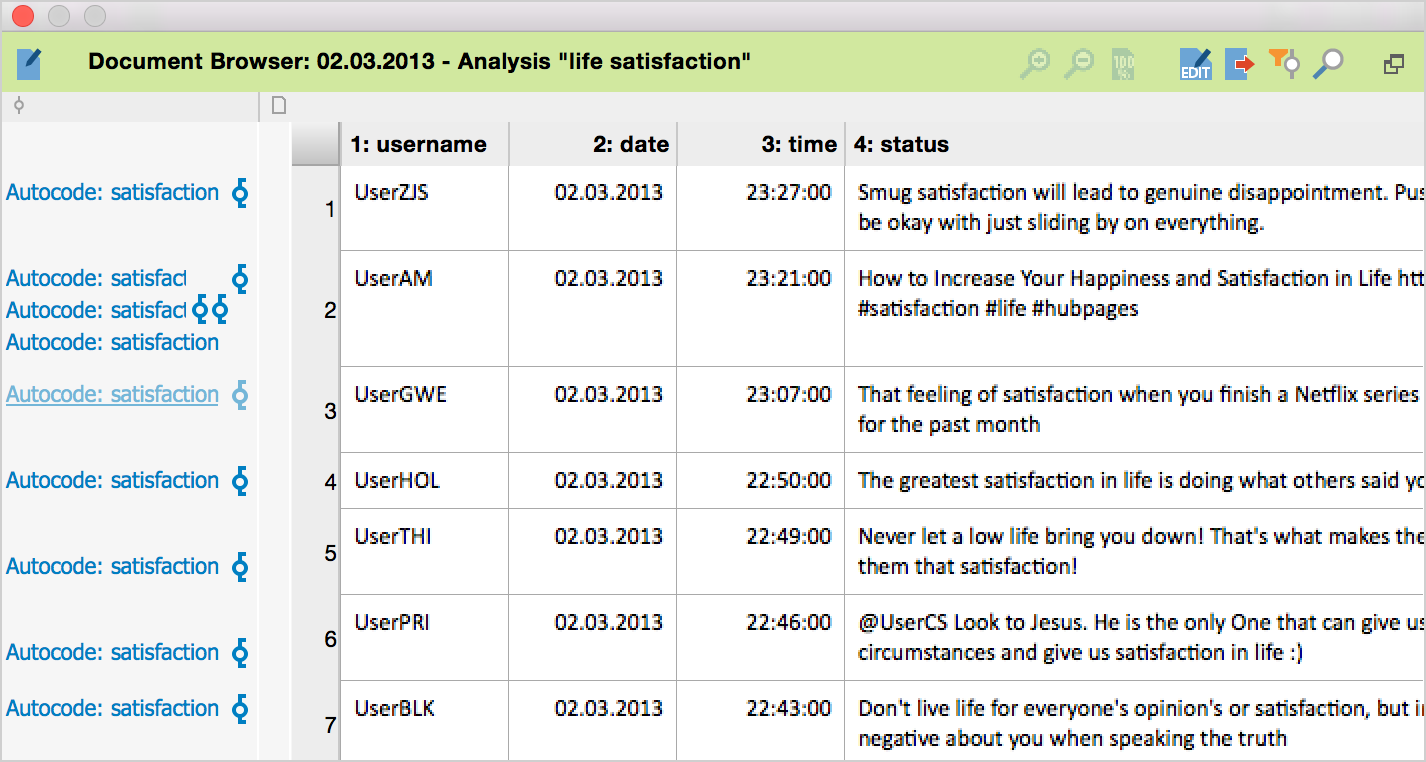
Table documents are indicated in the “Document System” with a ![]() symbol.
symbol.
Creating Table Documents
From the menu function Documents > Create document, you can create a new table directly in MAXQDA and select the number of columns and rows.
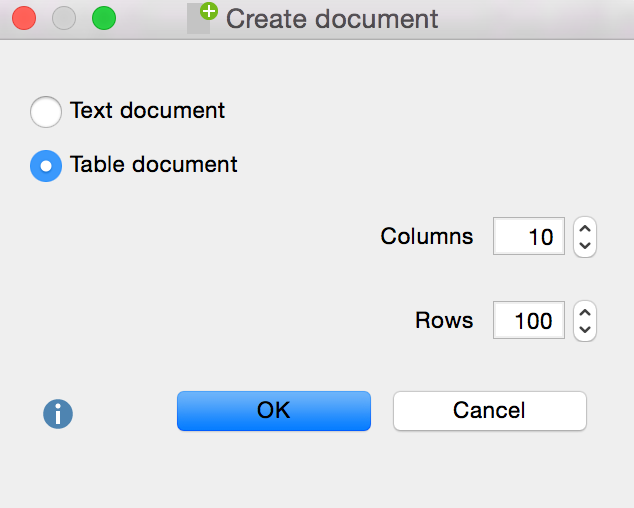
The Table View in the “Document Browser”
Table documents in MAXQDA will be automatically formatted. It is not possible to modify the text format.
You can zoom in to the table using the zoom icon in the “Document Browser” toolbar. The font will appear accordingly larger or smaller. The height of the rows will be automatically set to the height of the largest cell.
Notes on the Columns
Columns will be numbered according to their order in the Excel table when imported. The column number appears at the beginning of each column header and cannot be modified after the import. The column numbers for coded segments, memos and references are assigned as page numbers, so there is no risk of ambiguity.
When the table document is imported, the first row of the imported document will become the column header. This column header can be modified by right-clicking on the column and selecting Edit:
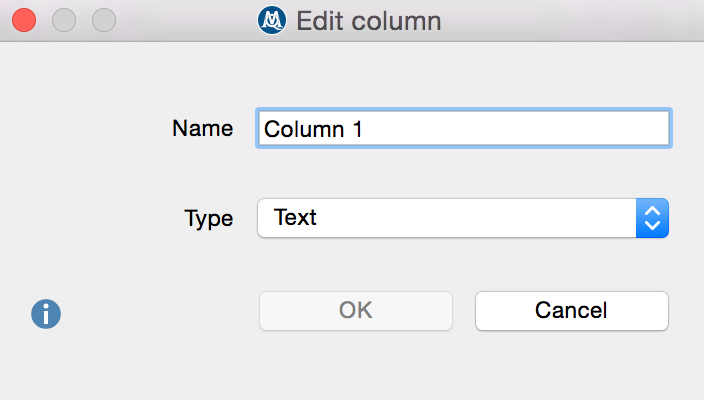
When you import a table each column will be assigned a type automatically:
- Text
- Numeric
- Date/Time
To change a column type, open the drop-down menu “Type.”
The column widths and column positions can be modified using Drag & Drop. Like overview tables, table documents in MAXQDA can be sorted by clicking the column header. The original order can always be restored by right-clicking on the column header and selecting Reset sorting. Alternatively, you can click on the empty column header just above the row number.
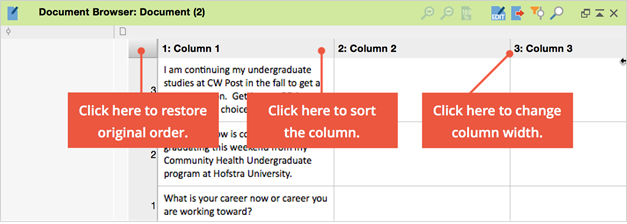
You can access the following options by right-clicking on the column header:
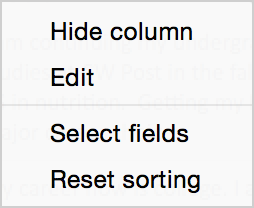
Hide – hides the column.
Edit – allows the modification of column name and column type.
Select fields – opens a window in which the columns to be displayed can be selected.
Reset Sorting – restores original order after import.
Notes on Table Rows
The row numbers are fixed when the table is imported into MAXQDA, and cannot be modified.
A row in the table corresponds to exactly one paragraph. Within a cell, there is no differentiation between paragraphs.
Edit Table Documents
The contents of individual cells can be modified. In order to do so, click on the Edit mode on/off ![]() button in the toolbar of the “Document Browser”.
button in the toolbar of the “Document Browser”.
The Windows clipboard can also be used with table documents. To copy the contents of an activated cell onto the clipboard, right-click on the cell or press Ctrl+C. In Edit mode, you can paste the contents from the clipboard into an activated cell by right-clicking the mouse or by pressing Ctrl+V.
Coding Table Documents
Any text segment of any cell can be coded. First, double-click on the cell in order to select the contents. The cell will then be outlined in yellow, and you can mark a text segment. All of the usual MAXQDA coding options, including color-coding and coding with emoticons, are now available. It is not possible to code across multiple cells.
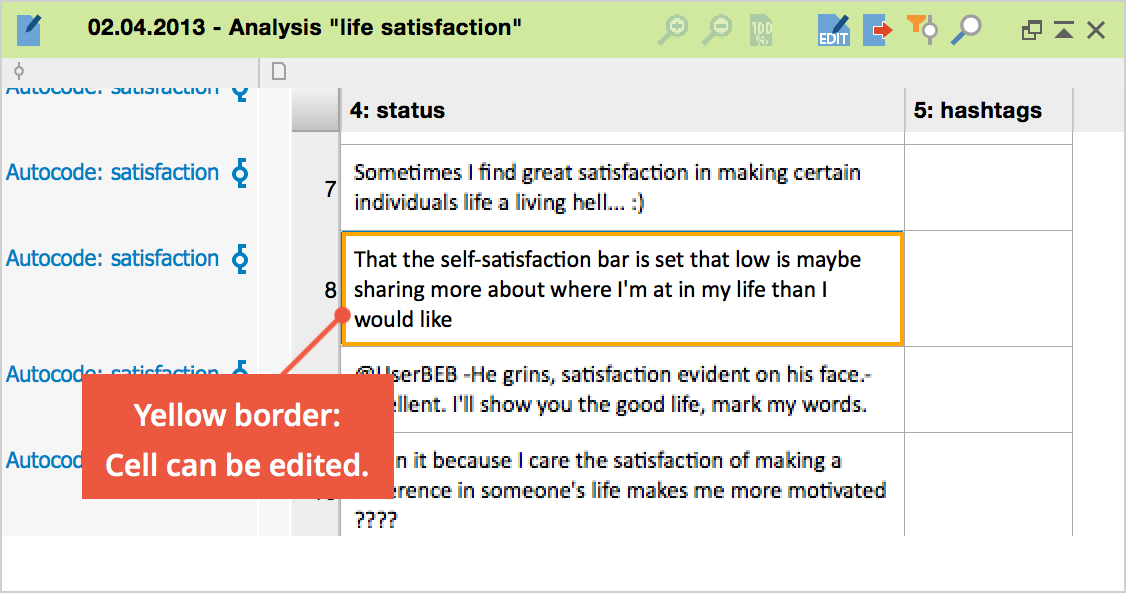
Notes on Retrieval Functions in Table Documents
The retrieval options for coded segments in table documents are identical to those for text documents. For example, overlap will be handled in the same way as it is with normal text. The retrieval functions also include hidden columns and are based on the current configuration of the table. Retrieval functions for a single row correspond to those for a single paragraph.
The Near function in the Code Relations Browser and Complex Coding Query applies to columns in table documents. This means that only the vertical proximity of two codes, and not the horizontal or diagonal proximity, will be taken into account, and that coded segments in different columns will never be found, when using the Near function.
Click on the source data in the “Retrieved Segments” to indicate the coded text in the “Document Browser” and display the corresponding column.
Memos in Table Documents
As with all documents in MAXQDA, you can assign memos to table documents. Memos can be assigned to individual cells. There are two ways to assign a memo to a cell:
- Double-click in the grey memo field next to the table, or
- Right-click on a cell or marked text segment within a cell and select New Memo.
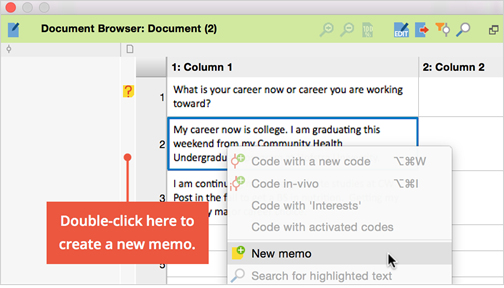
When you click on a menu symbol, MAXQDA will indicate to which cell this memo is assigned.
Table Documents and Visual Tools
In principle, hidden columns in table documents will be taken into account when using Visual Tools.
Code Matrix Browser functions as with any other type of document, as only the number of coded segments for a particular code will be analyzed.
Code Relations Browser functions as with overlapping in normal text. Overlap can only occur within a particular cell. The “Near” function will search only for coded segments in the same column.
Codeline Each row represents a paragraph in the Codeline - the column structure is ignored in this case. Hidden columns will be taken into account. Paragraphs will be sorted in their original order.
Document Comparison Chart As with the Codeline, each row in the table represents a paragraph - the column structure is ignored. Hidden columns will be taken into account. Paragraphs will be sorted in their original order.
Document Portrait This tool operates differently than with regular documents. Columns will be more or less ignored; cells will be processed from left to right, then top to bottom. A one-dimensional structure is then created, which is displayed as usual in the Document Portrait.
Exporting Table Documents
Table documents cannot be printed directly from MAXQDA; they can however be exported in Excel format. Click the Export Displayed Document button ![]() in the Document Browser or select Project > Print > Displayed Document from the main menu. Alternatively, you can right-click on the document in the “Document System” and select Export.
in the Document Browser or select Project > Print > Displayed Document from the main menu. Alternatively, you can right-click on the document in the “Document System” and select Export.
